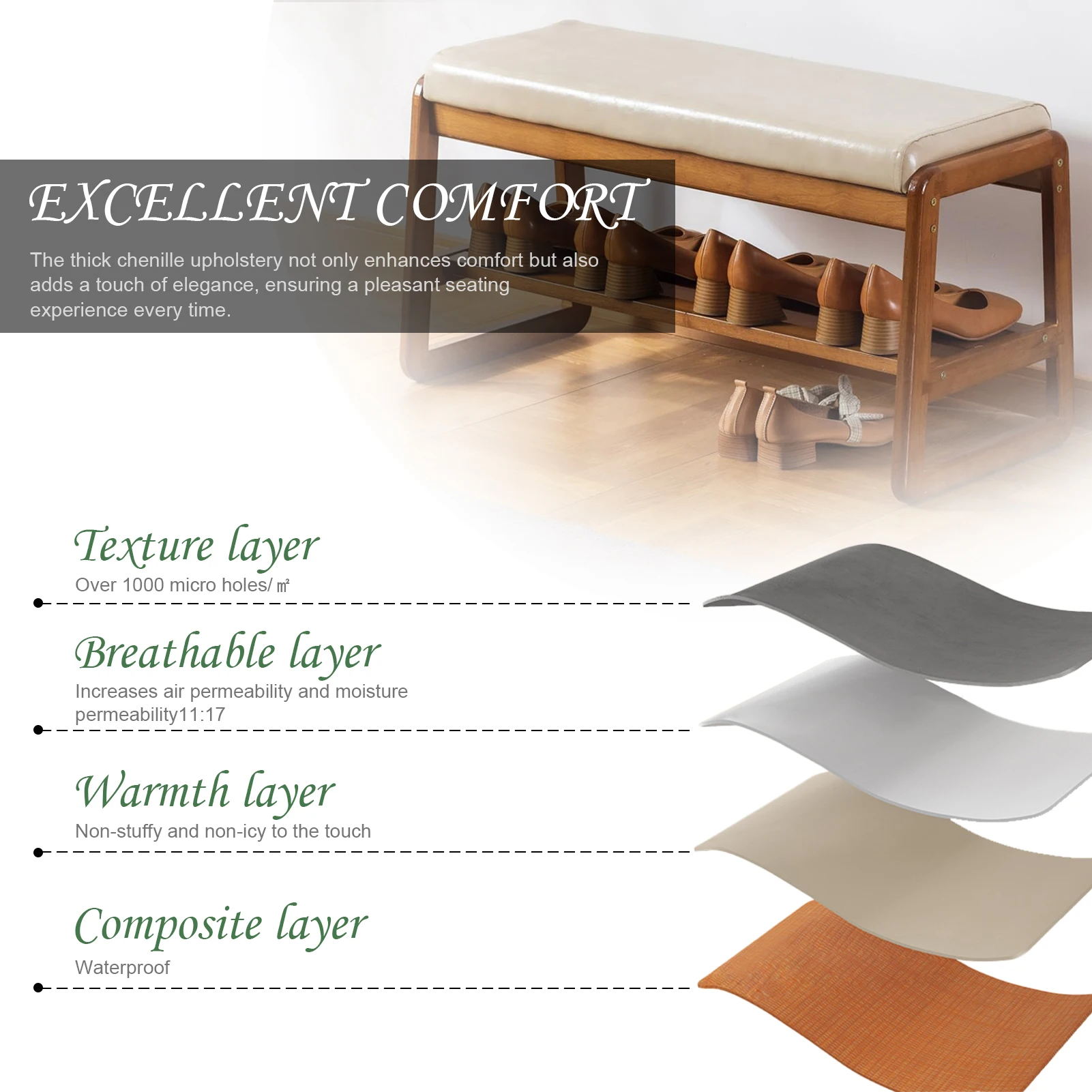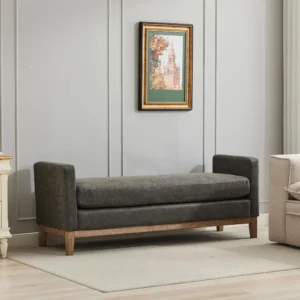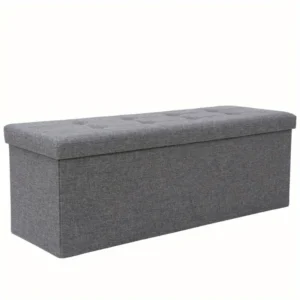Corner spaces in homes often become awkward, unused areas that leave us scratching our heads about how to make them functional. Enter corner bench seating: the perfect solution that transforms these challenging spaces into stylish, practical areas for gathering, dining, or simply relaxing. These versatile pieces not only maximize your available space but also add character and warmth to any room. In this comprehensive guide, we’ll explore how corner bench seating can revolutionize your home layout, examine various designs for different rooms, and provide practical advice on selecting the perfect option for your needs. At Nested Goods, we believe that smart furniture should never sacrifice style for function – and corner bench seating perfectly embodies this philosophy by transforming your entryway with space-saving benches that make every square inch count.
I. Why Corner Bench Seating is the Ultimate Space-Saving Solution
Corners present unique challenges in home design. They’re often awkward, difficult to furnish, and can quickly become wasted space. Traditional furniture arrangements typically leave corners empty or utilize them inefficiently, creating dead zones in your floor plan. Corner bench seating addresses these problems head-on by perfectly conforming to these challenging angles while providing multiple benefits.
The brilliance of corner bench seating lies in its ability to maximize seating capacity while minimizing the footprint. Where traditional seating might accommodate only 3-4 people around a table in a small dining area, a well-designed corner bench can comfortably seat 5-6 in the same space. This efficient use of square footage makes corner benches particularly valuable in space-saving entryway ideas and other tight areas of your home.
A. Transforming Awkward Corner Spaces into Functional Areas
Corners often become the forgotten spaces in our homes. In kitchens, they might collect rarely used appliances; in living rooms, they often sit empty or hold a lonely plant; and in entryways, they frequently become cluttered catch-all spots. These spaces are challenging because standard furniture doesn’t fit properly, creating awkward gaps or traffic flow issues.
Corner bench seating is specifically designed to address these pain points. By using the exact dimensions and angles of your corner, these pieces transform previously unusable areas into highly functional seating that feels like a natural extension of your room. Particularly in entryways, a corner entryway bench can turn an empty corner into a welcoming spot to sit while putting on shoes, dropping off bags, or organizing daily essentials.
B. Measurable Space-Saving Benefits
When comparing traditional seating arrangements to corner bench options, the space-saving benefits become immediately apparent:
- Greater seating capacity: A corner bench can seat up to 6 people in a 24 square foot space compared to just 4 with individual chairs using the same area.
- Reduced clearance needs: Chairs require 24-36 inches (61-91 cm) of pullout space behind them for comfortable access, while bench seating eliminates this requirement against walls.
- Improved traffic flow: Without chair backs extending into walkways, movement around the room becomes more fluid and spacious.
- Vertical space utilization: Many corner benches extend higher on the wall, making use of vertical space that would otherwise be wasted.
These tangible benefits make corner bench seating a smart choice for anyone looking to maximize their available living space without sacrificing comfort or style.
C. Additional Advantages Beyond Space Efficiency
Beyond just saving space, corner bench seating offers several other significant benefits that enhance your home’s functionality and appearance.
The defined seating area created by a corner bench helps establish clear zones in open-concept spaces, making rooms feel more organized and purposeful. This subtle spatial division can help a large room feel cozier or make a multipurpose space more functional.
Built-in storage is perhaps one of the most valuable secondary benefits of corner bench seating. Many designs incorporate lift-top seats, drawers, or cubbies that provide hidden storage for items like seasonal decorations, extra table linens, or children’s toys – effectively doubling the functionality of the piece.
Corner benches also create a more intimate seating arrangement that encourages conversation and connection. The L-shaped configuration naturally positions people closer together and at angles conducive to interaction, making mealtime or gatherings more engaging.
II. Most Popular Types of Corner Bench Seating Designs
Corner bench seating comes in several distinct styles, each suited to different spaces and needs. Understanding the differences between these designs will help you identify which option best fits your specific requirements for both function and aesthetics. From casual kitchen nooks to formal dining setups and practical entryway solutions, there’s a corner bench configuration ideal for every home. Let’s explore the most common types and their unique advantages when it comes to maximizing small spaces with smart entryway benches.
A. L-Shaped Corner Benches
L-shaped corner benches are the most versatile and common configuration, featuring two connected bench segments that meet at a 90-degree angle. This design efficiently hugs the corner while providing seating along two walls, making it ideal for dining areas and breakfast nooks.
Standard L-shaped benches typically extend 48-60 inches (122-152 cm) on each side, though custom options can be sized to fit specific spaces. This configuration can comfortably seat 4-6 people when paired with a few individual chairs on the open sides of a table. L-shaped designs come in various styles, from sleek contemporary pieces with clean lines to rustic farmhouse versions with distressed finishes.
The arm design on L-shaped benches significantly impacts both style and function. Armless designs maximize seating capacity and allow for easier entry and exit, while those with a single arm on the end add a finished look. Full-armed versions create a more sofa-like appearance but slightly reduce the number of people who can sit comfortably.
B. Banquette Seating Solutions
Banquette seating refers specifically to built-in or semi-built-in bench seating designed primarily for dining areas. Unlike standalone L-shaped benches, banquettes are typically fixed in place and often feature upholstered backs for additional comfort during longer sitting periods. These designs are particularly popular in breakfast nooks, kitchen dining areas, and restaurants.
The beauty of banquette seating lies in its ability to combine the space efficiency of bench seating with the comfort of booth-style restaurant seating. These pieces typically feature deeper cushioning and entryway bench cushions that invite you to linger over meals. Banquettes pair beautifully with round or pedestal tables, which eliminate the issue of table legs interfering with seating positions.
Banquettes can be fully built-in as architectural elements or designed as furniture pieces that give the appearance of built-ins while allowing for future flexibility. The former provides a custom, seamless look, while the latter offers the potential to reconfigure your space down the road.
C. Window Corner Bench Designs
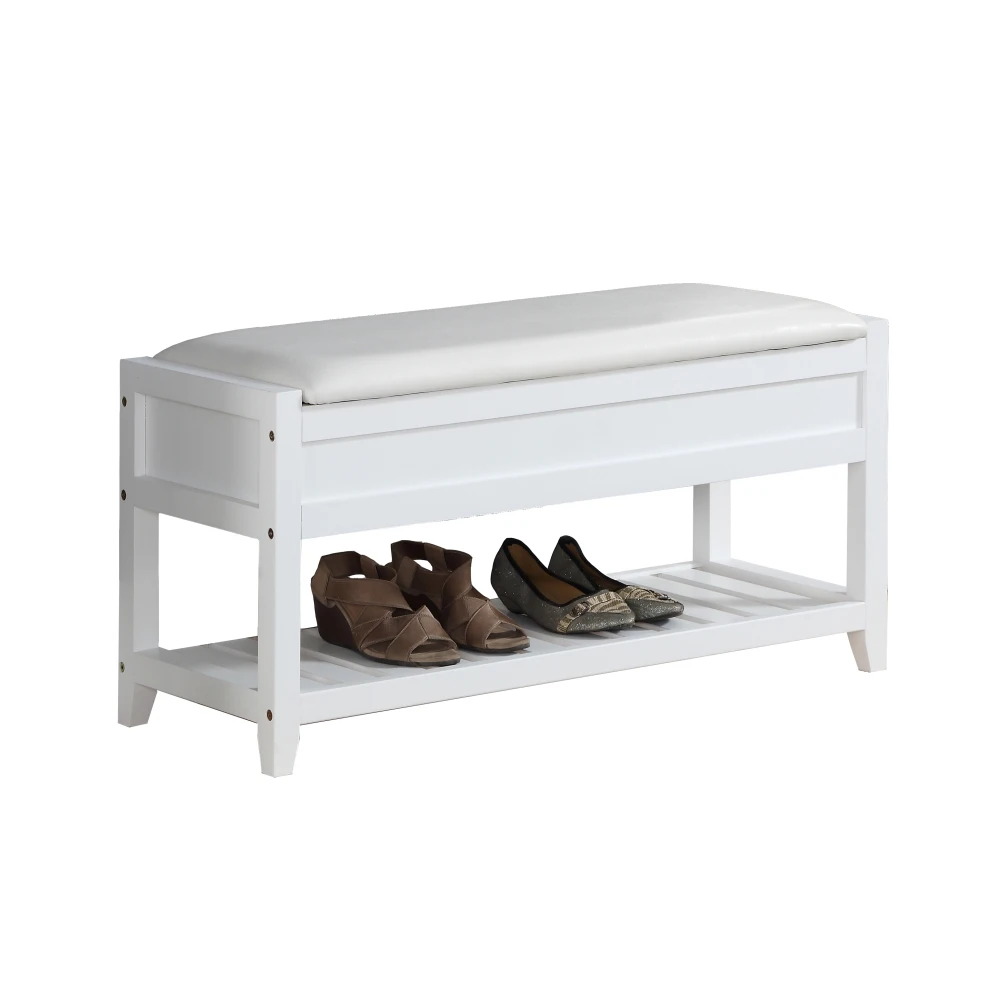
Window corner benches take advantage of natural light while maximizing seating in what might otherwise be underutilized space. These designs typically follow the contour of windows meeting at a corner, creating a bright, inviting nook perfect for reading, casual dining, or simply enjoying the view.
The ideal window bench has a depth of 18-20 inches (45-50 cm) – deep enough to sit comfortably but not so deep that it extends too far into the room. Window height is a critical consideration; the bench should be positioned so that the windowsill sits at a comfortable height relative to seated occupants, neither blocking the view nor creating an awkward sight line.
One of the greatest advantages of window corner benches is the storage potential beneath the seating surface. With hinged tops or front-facing drawers, these benches can store seasonal items, extra blankets, or children’s toys while maintaining a clean, uncluttered appearance.
D. Entryway & Mudroom Corner Solutions
Entryway and mudroom corner benches focus primarily on organization and transition functionality rather than extended seating comfort. These specialized designs are built to withstand the daily traffic of family members coming and going while providing essential storage for shoes, bags, and outerwear.
Mudroom corner benches typically stand 18-20 inches (45-50 cm) high and incorporate features like shoe cubbies beneath the seating surface, hooks above for coats, and sometimes additional shelving or cabinets. Materials for these pieces prioritize durability and easy cleaning, with solid wood, engineered wood with protective finishes, or even metal frames being popular choices.
The corner configuration is particularly valuable in entryways, where space is often at a premium. A corner hall tree combines vertical storage with seating to maximize functionality in minimal square footage, creating an organized landing zone that prevents clutter from spreading throughout the home.
III. Incorporating Storage into Your Corner Bench: Maximizing Functionality
One of the most compelling reasons to choose corner bench seating is the opportunity to integrate storage into your seating solution. This dual functionality transforms a simple seating area into a hardworking organizational tool that helps contain clutter while maximizing your available space. Strategic storage integration can significantly enhance the practical benefits of your corner bench, making it an investment in both comfort and organization.
The storage capacity of corner benches varies widely based on design and dimensions. A typical 48-inch (122 cm) bench seat can provide approximately 3 cubic feet (0.08 cubic meters) of storage space – enough for several pairs of shoes, seasonal accessories, table linens, or children’s toys. This hidden storage helps maintain a clean, uncluttered appearance while keeping frequently used items close at hand.
A. Hidden Storage Mechanisms
Corner benches can incorporate several different storage solutions, each with specific advantages for particular uses:
Lift-top storage: This classic design features a hinged seat that lifts to reveal a storage compartment beneath. Lift-tops provide the largest continuous storage space and work well for bulkier items. Look for models with safety hinges that prevent accidental slamming.
Drawer storage: Front-facing drawers offer more convenient access without requiring users to remove items from the seating surface. Drawers work exceptionally well for smaller items that might get lost in a larger compartment and allow for better organization through separation.
Open cubbies: Some corner benches feature open storage below, often divided into cubby spaces perfect for shoes, baskets, or decorative storage bins. While less concealed than other options, cubbies provide the easiest access and can be dressed up with attractive storage containers.
Combination approaches: Many higher-end entryway bench storage solutions incorporate multiple storage types, such as drawers plus a lift-top section, to provide versatility for different storage needs.
When selecting your storage mechanism, consider how frequently you’ll need to access the items stored inside. For daily essentials, easy-access drawers or cubbies make more sense, while seasonal items are well-suited to lift-top compartments.
B. Room-Specific Storage Solutions
Different rooms benefit from tailored storage approaches in corner bench designs:
For kitchen and dining areas, bench storage provides an excellent place for table linens, special occasion serving pieces, or small appliances used only occasionally. Consider dividers within the storage compartment to keep tablecloths and napkins neatly separated and wrinkle-free.
In entryways, focus on shoe storage, seasonal accessories like hats and gloves, and everyday items like bags and backpacks. Modular organizers inside lift-top storage can help maintain order, while a combination of open cubbies for frequently worn shoes and concealed storage for seasonal footwear offers maximum functionality.
Living room corner benches benefit from storage designed for entertainment items, extra throw blankets, or board games. If your corner bench serves as auxiliary seating in a living space, consider how the storage might complement your existing entertainment storage rather than duplicating it.
The beauty of unlocking hidden space with narrow bench seats is that you can customize the interior organization to suit your specific needs, regardless of which room houses your corner bench.
IV. Design Ideas for Every Room: Where to Place Your Corner Bench
Corner bench seating offers remarkable versatility, with applications extending to nearly every room in your home. From practical kitchen dining solutions to cozy reading nooks in living spaces and organized entryways, understanding the ideal placement and configuration for each room will help you maximize both the functional and aesthetic benefits of your corner bench. Let’s explore how these space-saving pieces can transform different areas of your home.
A. Kitchen & Dining Area Applications
Kitchen and dining areas perhaps benefit most from corner bench seating, where the space efficiency creates generous seating without overwhelming the room. A typical breakfast nook with corner bench seating requires just 25-30 square feet (2.3-2.8 square meters) to comfortably accommodate 4-6 people – significantly less than a traditional dining table with chairs all around.
When designing a dining corner bench, table selection becomes critical. Round or square tables work best with symmetrical L-shaped configurations, while rectangular tables complement asymmetrical designs where one bench side is longer than the other. A pedestal table base eliminates the problem of table legs interfering with seating positions and allows for easier entry and exit.
For dining applications, pay special attention to the height relationship between the bench and table. The standard dining height places the bench seat 18 inches (46 cm) from the floor, with about 12 inches (30 cm) of clearance between the seat and table underside. Materials for kitchen and dining bench seating should prioritize easy cleaning, with stain-resistant fabrics or wipeable surfaces like leather, vinyl, or wood.
B. Living Room Corner Optimization
In living rooms, corner benches create intimate conversation areas or peaceful reading nooks while making use of otherwise awkward corner spaces. Window corners are particularly valuable locations, combining natural light with cozy seating potential.
Living room corner benches can serve as transitions between different furniture groupings or as extensions of your primary seating arrangement. Consider how traffic flows around the corner bench and ensure there’s at least 30 inches (76 cm) of clearance for comfortable movement through the space.
Since living room seating typically involves longer sitting periods, comfort becomes paramount. Consider a deeper seat depth of 20-22 inches (51-56 cm) and add plush cushions and pillows to enhance comfort. Backrests are particularly important for living room applications, with an ideal back height of at least 12-18 inches (30-46 cm) above the seat for proper support.
C. Entryway & Mudroom Organization
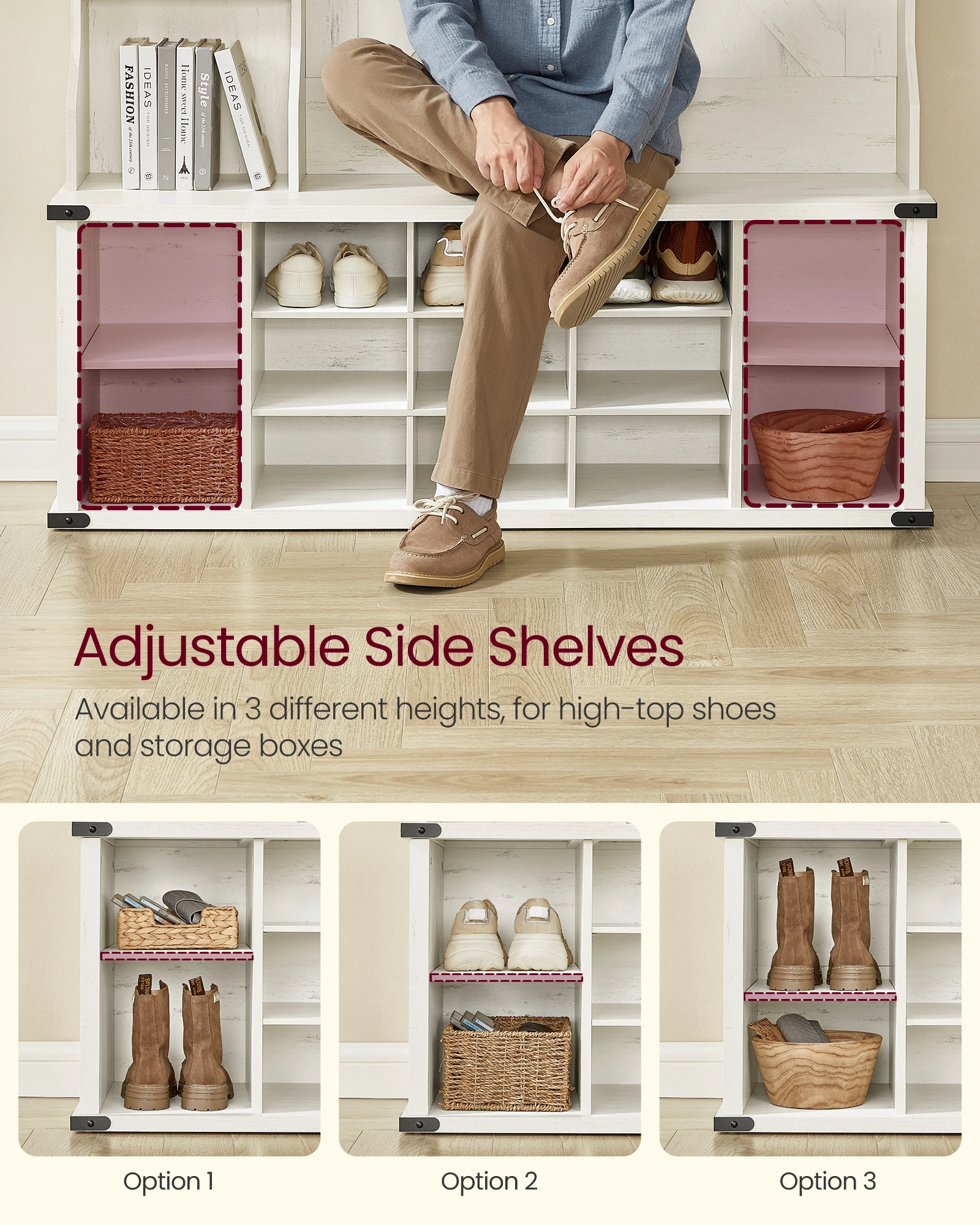
Entryways and mudrooms benefit tremendously from corner bench designs that maximize organization in typically small spaces. A corner configuration makes efficient use of available square footage while providing a dedicated place to sit when putting on or removing shoes.
An effective entryway corner bench typically measures 18 inches (46 cm) high and 16-18 inches (40-46 cm) deep – comfortable enough for brief sitting while changing shoes without protruding too far into the walkway. Pair your entryway benches with vertical storage like hooks, shelves, or a full hall tree configuration to create a complete organization system.
In high-traffic entryways, durability becomes essential. Look for solid construction with reinforced corners and sturdy materials that can withstand daily use. Water-resistant finishes are particularly valuable in mudroom applications, where wet shoes and clothing are common. Incorporate washable cushions or upholstery that can be easily cleaned when inevitable dirt and grime appear.
Entryway Bench with Cushion, Mudroom Bench with Cushion, Shoe Bench for Entryway
$1,186.63 Select options This product has multiple variants. The options may be chosen on the product pageCoat Rack Shoe Bench, Corner Entryway Bench, Corner Hall Tree, Shoe Bench for Entryway
$313.58 Select options This product has multiple variants. The options may be chosen on the product pageEntryway Bench with Back, Modern Entryway Bench, Shoe Bench for Entryway
Price range: $463.13 through $474.44 Select options This product has multiple variants. The options may be chosen on the product pageEntryway Bench with Shelf Storage, Shoe Bench for Entryway, Shoe Storage Bench
$194.08 Select options This product has multiple variants. The options may be chosen on the product pageCorner Entryway Bench, Entryway Bench with Cushion, Modern Entryway Bench, Shoe Bench for Entryway
$476.34 Select options This product has multiple variants. The options may be chosen on the product pageModern Entryway Bench, Wood Entryway Bench, Wood Mudroom Bench
$497.69 Select options This product has multiple variants. The options may be chosen on the product page
V. Material Selection & Comfort Considerations
The materials you select for your corner bench will significantly impact both its appearance and functionality. Different materials offer varying levels of durability, comfort, and maintenance requirements, making it essential to choose options aligned with your specific needs and the bench’s location. Similarly, comfort features can transform a basic bench into an inviting seating area where family and friends will want to linger.
A. Selecting Durable Materials for High-Use Areas
Material selection should be guided primarily by the bench’s location and expected level of use. For high-traffic areas like entryways and kitchens, prioritize durability and easy cleaning over plush comfort.
Hardwoods like oak, maple, and walnut offer exceptional durability and a timeless appearance, though they come at a higher price point. These materials can withstand years of daily use with proper care and develop a beautiful patina over time. Engineered woods provide a more budget-friendly alternative while still offering good durability when properly sealed and finished.
For upholstered portions, performance fabrics designed specifically for high-traffic areas offer the best combination of comfort and durability. Look for options with high rub counts (15,000+ double rubs), stain resistance, and easy cleaning properties. Leather and quality vinyl alternatives provide excellent durability in households with children or pets, as they can be quickly wiped clean.
For outdoor or semi-outdoor spaces like enclosed porches, consider weather-resistant materials like treated woods, metal frames with appropriate finishes, or synthetic wicker paired with outdoor-rated cushions. These materials can withstand temperature fluctuations and occasional moisture exposure without warping or deteriorating.
B. Comfort Features for Extended Sitting
The comfort of your corner bench directly impacts how much it will be used, particularly in areas designed for longer sitting periods like dining areas and living spaces.
Seat depth is a critical comfort factor, with 16-18 inches (40-46 cm) being ideal for dining applications where a more upright position is preferred. For lounging or casual seating, increase the depth to 20-22 inches (51-56 cm) to allow for a more relaxed posture. The standard bench height of 18 inches (46 cm) works well for most adults, though adjustments may be needed to align properly with existing tables.
Cushion density significantly affects both comfort and longevity. High-density foam (1.8 pounds per cubic foot or higher) provides the best support without compressing too quickly with regular use. Consider a combination of foam core with a softer wrap layer for the ideal balance of support and comfort.
Back support becomes increasingly important the longer people will be sitting. An ergonomic back angle of approximately 10-15 degrees provides comfortable support without taking up too much space. For dining applications, a back height of 10-12 inches (25-30 cm) above the seat is sufficient, while living area seating benefits from taller backs of 15-18 inches (38-46 cm).
C. Styling Your Corner Bench to Match Your Decor
Your corner bench should complement your existing décor while making its own subtle style statement. For contemporary spaces, clean lines and minimalist details work best, often featuring solid colors and simple geometric patterns. Traditional homes benefit from classic details like tufting, nailhead trim, or turned legs that reference historical furniture styles.
Color selection plays a crucial role in how your corner bench integrates with your space. For smaller rooms, selecting a bench color that closely matches your wall color creates visual continuity that makes the space feel larger. Conversely, a contrasting color creates a focal point and defines the seating area more distinctly.
Consider the season and how easily you can update the look. Fixed upholstery commits you to a specific style, while slipcovers or cushion covers allow for seasonal changes or updates as your taste evolves. Similarly, accessories like pillows and throws can refresh the look of your corner bench without requiring full replacement.
VI. Measuring Your Space: Getting the Perfect Fit
Proper measurements are crucial for ensuring your corner bench fits perfectly in your space while providing comfortable seating and adequate clearance for movement. Taking time to measure accurately before purchasing or designing a corner bench will save considerable frustration and potential disappointment. Follow these guidelines to ensure your corner seating solution fits precisely where and how you need it.
A. Step-by-Step Measurement Guide
Start by clearing the corner area completely to allow for accurate measurements without obstacles.
Measure the wall lengths where the bench will be placed, starting from the corner and extending to where you want the bench to end on each wall. Record both measurements separately.
Check for square corners using the 3-4-5 method: Measure 3 feet along one wall and make a mark, then measure 4 feet along the adjacent wall and make another mark. The diagonal distance between these marks should be exactly 5 feet if the corner is square. If not, note the actual angle for custom planning.
Measure the height of any windows or obstacles that might affect the bench placement, including the height from the floor to windowsills.
Determine your desired bench depth (typically 16-20 inches or 40-51 cm) and ensure this won’t interfere with walkways or door openings.
Mark the floor with painter’s tape to visualize the footprint of your proposed bench and live with it for a day to ensure it doesn’t impede traffic flow.
Maintain at least 36 inches (91 cm) of clearance for walkways and a minimum of 24 inches (61 cm) of space between a bench edge and any table edge for comfortable seating.
For dining applications, ensure approximately 12 inches (30 cm) of space between the seat and the table underside for comfortable leg positioning.
B. Accounting for Windows, Doors, and Other Obstacles
Common architectural features can complicate corner bench placement but don’t necessarily rule it out. Baseboards often create a gap between the bench and wall; either notch the bench to accommodate them or remove the baseboards in that section if the bench is a permanent installation.
Electrical outlets require special attention, as covering them with furniture creates both inconvenience and potential safety hazards. Consider incorporating access points into your bench design, relocating outlets, or selecting a bench design that doesn’t fully obstruct wall access.
Windows present both challenges and opportunities. Ideally, bench seating should stop just below windowsills, creating a seamless look without blocking natural light. If windows extend lower, consider a bench with a lower back height or an open design that doesn’t block the window.
For angled or irregular corners (not 90 degrees), custom solutions may be necessary. Many furniture makers offer customization services, or built-in options can be constructed to fit perfectly in these challenging spaces.
VII. Finding the Right Corner Bench: Shopping Guide
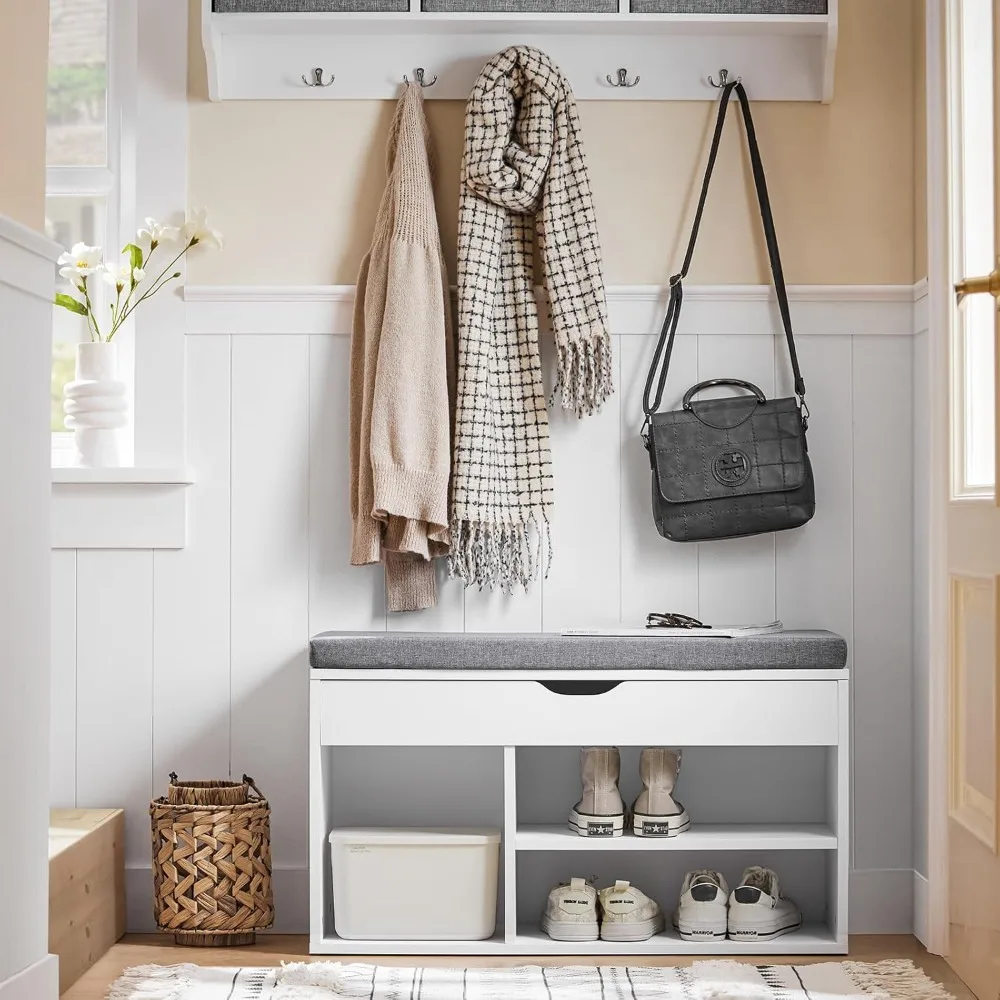
With a clear understanding of your space requirements and design preferences, it’s time to explore the available corner bench options. Whether you choose a ready-made solution or opt for custom design, knowing what to look for ensures you’ll select a piece that serves your needs for years to come. This complete guide to choosing compact benches will help you navigate the various options and make an informed decision.
A. Ready-Made vs. Custom Options
Ready-made corner benches offer immediate availability and typically lower costs, with prices ranging from $200-$800 depending on size, materials, and features. These prefabricated options work well for standard 90-degree corners and come in a variety of styles to match different decor themes. The primary limitations include restricted size options, standard features that may not perfectly match your needs, and potential assembly requirements.
Custom corner benches provide perfect fits for unusual spaces, personalized features, and tailored dimensions to match your exact requirements. While they typically cost 30-50% more than ready-made options (generally $500-$2000+) and involve longer lead times (3-8 weeks), the investment results in a piece precisely suited to your space and needs. Custom options are particularly valuable for non-standard corner angles, unusual dimensions, or specific feature requirements like extra storage configuration.
Semi-custom options bridge the gap between these approaches, offering some customization within a manufacturer’s standard framework. These pieces allow you to select specific dimensions within a range, choose from multiple finish options, and sometimes customize features like storage type while keeping costs lower than fully custom work.
B. Key Quality Indicators to Look For
When evaluating corner bench options, several construction features indicate quality and durability:
Frame Construction: Look for hardwood frames with reinforced corners using proper joinery methods like mortise and tenon or dowel construction rather than just glue and staples.
Weight Capacity: Quality benches should support at least 250-300 pounds per bench section. Manufacturers should be able to provide specific weight ratings.
Upholstery Details: Examine seams for straight, even stitching with no loose threads. Patterns should align properly at seams, and fabric should be pulled tight without wrinkles.
Cushion Construction: High-density foam (1.8+ pounds per cubic foot) retains shape longer. Removable cushions with zippers suggest the manufacturer stands behind their quality and allows for cleaning or replacement.
Storage Mechanisms: Test hinges and drawers for smooth operation. Soft-close features indicate attention to detail, while safety hinges on lift-tops prevent accidental slamming.
Warranty Coverage: Look for at least a 1-year warranty on manufactured pieces, with higher-end options often offering 3-5 years of coverage on frame construction.
When shopping for small entryway benches or larger corner solutions, these quality indicators help ensure your investment will stand the test of time and daily use.
VIII. Caring for Your Corner Bench: Maintenance Tips
Proper maintenance ensures your corner bench remains beautiful and functional for years to come. Different materials require specific care approaches, and understanding these requirements helps you protect your investment while keeping your seating area looking its best.
A. Material-Specific Cleaning Guidelines
For wooden elements:
* Dust regularly with a soft, dry cloth to prevent buildup that can scratch surfaces over time
* Clean spills immediately using a slightly damp cloth, then dry thoroughly
* Apply furniture polish or wood conditioner every 3-4 months to maintain moisture and prevent cracking
* Avoid placing wooden benches in direct sunlight, which can cause fading and drying
For upholstered portions:
* Vacuum regularly using an upholstery attachment to remove dust and debris
* Treat spills immediately – blot (don’t rub) liquids with a clean, dry cloth
* For fabric upholstery, use appropriate fabric cleaners matched to your specific material type
* Consider applying fabric protector spray to prevent staining (test in an inconspicuous area first)
* For leather or vinyl, use cleaners specifically formulated for these materials and apply conditioner to leather every 6-12 months
For metal components:
* Wipe with a soft cloth dampened with mild soap solution, then dry thoroughly
* Check periodically for any signs of rust and address immediately
* Apply appropriate metal polish as needed to maintain finish
B. Extending the Life of Your Corner Seating
Implement a quarterly maintenance routine that includes tightening any loose screws or hardware, as regular use naturally causes these elements to loosen over time. Pay special attention to hinges on storage benches that see frequent opening and closing.
For upholstered benches, rotate cushions regularly (if removable) to ensure even wear. This simple step can significantly extend the life of your cushions and maintain consistent comfort across the bench.
Protect wooden surfaces from heat and moisture by using coasters under drinks and placemats under dishes. These small precautions prevent rings and water damage that can permanently mark wood surfaces.
Consider seasonal deep cleaning to address areas that might be missed in regular maintenance. Remove cushions to vacuum underneath, clean inside storage compartments, and inspect the bench structure for any issues that might need attention.
For benches showing signs of age, consider refreshing rather than replacing. Reupholstering cushions or refinishing wood surfaces can give your corner bench new life at a fraction of the cost of replacement, particularly for high-quality pieces with solid construction.
IX. Maximize Your Small Space: Additional Space-Saving Tips
While corner bench seating itself is an excellent space-saving solution, complementing it with other strategic furniture choices and design approaches can further enhance your room’s efficiency and visual spaciousness. These additional techniques work synergistically with your corner bench to create a cohesive, functional space that feels larger and more organized than its actual dimensions might suggest. Explore these space-efficient mudroom bench solutions to create a comprehensive space-saving strategy.
A. Complementary Space-Saving Furniture
Select furniture pieces that enhance rather than compete with your corner bench seating. Pedestal or tulip-style tables eliminate bulky legs that can interfere with bench access while creating a visually lighter appearance. Round tables work particularly well with corner benches, allowing more people to sit comfortably without sharp corners impeding movement.
Consider nesting tables or expandable designs that can be adjusted based on your current needs. These versatile pieces provide flexibility without permanently consuming valuable floor space when not in full use.
For additional seating, lightweight stools or ottomans that can tuck completely under tables or into unused spaces provide seating when needed without cluttering your room when not in use. Look for options with hidden storage inside for even greater functionality.
Vertical storage solutions that build upward rather than outward complement corner benches beautifully. Wall-mounted shelving, floating cabinets, or tall, narrow bookcases maximize storage capacity while maintaining open floor space that contributes to a room feeling larger and more navigable.
B. Design Tricks to Make Small Spaces Feel Larger
Strategic color choices dramatically impact spatial perception. Using the same color for your corner bench and the surrounding walls creates visual continuity that makes the bench appear built-in and the room more spacious. Light, cool colors typically make spaces feel larger and more open, while warm, dark colors create coziness but can make spaces feel smaller.
Mirrors strategically placed near your corner seating arrangement reflect light and visually double the perceived space. Position mirrors to reflect windows or attractive views for maximum impact on spatial perception.
Proper lighting transforms how spacious a room feels. Incorporate multiple light sources at different heights rather than relying on a single overhead fixture. Wall sconces, table lamps, and even LED strips under bench seating create layers of light that add dimension to your space.
Maintain a consistent style throughout your room rather than mixing too many different design elements. Visual cohesion creates a sense of intentional design rather than cluttered accumulation, making even small spaces feel well-planned and spacious.
By implementing these complementary strategies alongside your corner bench seating, you’ll create a space that feels open, organized, and thoughtfully designed – proof that small spaces can still offer both style and functionality without compromise.

